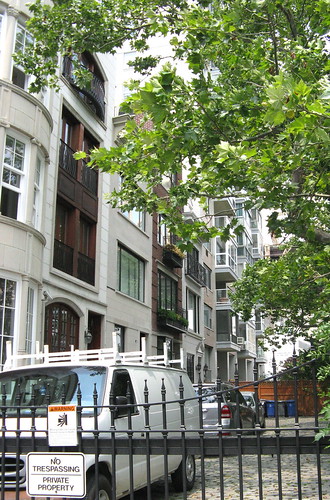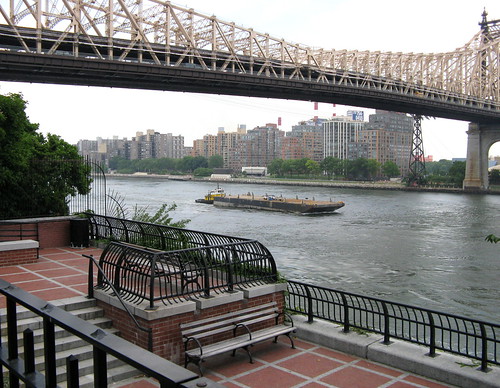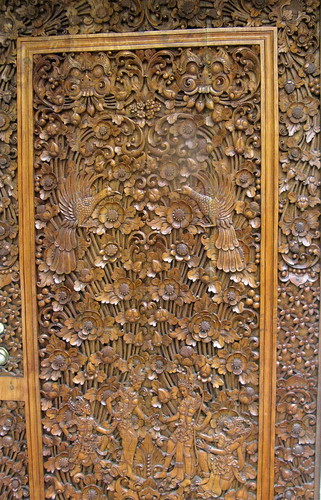In New York City, even two words can set off an intriguing exploration. An old guidebook I was perusing cited a “private street” on the far eastern side of Manhattan, where Midtown meets the Upper East Side, at Sutton Place. A private street in this city filled with hundreds of public streets?
Yes, it’s a place called Riverview Terrace, a cobblestoned street of just six townhouses behind a locked iron gate that is located between the east ends of Sutton Square (East 58th Street) and East 59th street. It’s one of New York’s relatively rare private streets. It fronts on a lush, tree-filled rectangular garden, also behind a gate, that slopes down toward the East River. The homes are elegant beauties (and expensive ones at that), a mix of modern and later 19th century styles. There’s no walking on Riverview Terrace for your average New York citizen or tourist.
Yet a small segment of a New York City park, Sutton Place Park, sits next to Riverview Terrace and helps make the trek in 90-degree-plus heat worthwhile. Located beside Riverview Terrace, this tiny two-tiered, red-brick courtyard, trimmed in wrought iron, has an open view of the East River, Queensboro Bridge, Roosevelt Island, Queens, and downriver, Brooklyn. It’s a pleasing nook and an interesting juxtaposition: a little private street next to one of the tiniest sections of a New York public park, in a neighborhood once known for its industrial character and notorious gangs. The intersection of the park and street also holds a place in film history: Here Woody Allen shot an iconic view of the Queensboro Bridge for the film Manhattan.
Riverview Terrace surely is unknown to most in the city: Architecture critic Paul Goldberger once called it “an enclave of an enclave.” One could ride or walk dozens of times along Sutton Place, the avenue that runs north-south a block over, and never know this enticing place – Riverview Terrace and the northernmost portion of Sutton Place Park – exists.
Riverview Terrace
Sutton Place Park’s bi-level sitting area near Riverview Terrace
This corner of Manhattan feels separate and quiet, away from the city’s din, and the hum of cars and trucks across the bridge recedes to background. Sitting on a bench or standing at the iron fence feels like having your own fancy terrace, albeit taxpayer-supported, to enjoy the scene along the East River. First, there’s the steel sculpture in the sky of the Queensboro Bridge. The park provides a perch from which to meditatively watch the barges and tugboats heading up and down the river, to feel the breeze and smell the water, and to see the splashing of the barges.
The homes along Riverview Terrace and Sutton Square are well-kept and have eye-catching details. The house at 6 Sutton Square has an intricately carved wooden door with a profusion of human and animal figures. A sweet and peaceful St. Francis of Assisi statue holding a bird is on a home around the corner on Sutton Place. All seems to say that this is a spot to relax and leave behind the city’s bustle.
The front door at 6 Sutton Square
Once Gritty, Now Gated
Of course, this wasn’t always such a pristine and pricey corner of Manhattan. In the mid- and late 19th century, the East River waterfront teemed with tenements and industries such as a coal yard and brewery. A group of developers built two-dozen brownstones on the block bounded by East 58th and East 59th streets, an unusual choice since it happened at a time when many considered the riverfront to be a place of industry, according to Christopher Gray in the New York Times’ Streetscape column of Feb. 18, 1996.
The builders established the privacy from the beginning. On the east side of the block, they constructed a private street with a yard the residents owned in common, Gray explains. This was Riverview Terrace. Still, around the turn of the century, much of the neighborhood along the waterfront had become an eyesore, with deteriorating tenements and rough gangs known as the Dead End Kids.
A 1921 New York Times’ article described Riverview Terrace as “settled in the 1870s by ‘nice people’ in modest circumstances who were erratic enough to prefer a view of the river” to a more convenient location, according to Gray. Changes took hold in the early years of the 20th century. A steam company bought and demolished the northern six brownstones and the block to the south underwent redevelopment to stylish townhouses “for society people,” Gray writes. The six in the middle, Riverview Terrace, ultimately underwent various transformations, becoming sought-after residences. Meantime, starting in the early 1920s, nearby Sutton Place became a fashionable enclave of private houses drawing the wealthy and famous.
Various stars and public figures have been residents of Sutton Place, including Marilyn Monroe and then-husband Arthur Miller, Henry Kissinger, Mario Cuomo, and Sigourney Weaver, but Sutton Square, near the tiny park, was itself a star in Allen’s 1979 film, Manhattan. Seated on a bench with the Queensboro Bridge in view, Allen and Diane Keaton watch dawn come up. Cinematographer Gordon Willis and Allen shot the bridge scene at about 5 a.m., according to the independent movie magazine MovieMaker. Despite a problem that caused one of the city’s two necklaces of lights on the bridge to turn off (when the cinematographer had arranged for both to stay on even after dawn), the crew captured one of the most appealing, in-love-with-New-York film images ever done – and it became the movie’s poster.
Today, homes on Riverview Terrace go on the market for sky-high prices. The townhouse at 3 Riverview Terrace, with four bedrooms, a wood-paneled library “with Juliet balcony,” “private keyed garden,” and a staff apartment, has been on the market recently for an asking price of $15.5 million (dropped $3.5 million from $19 mil). The listings note that it has “spectacular” river views from each room.
Just several feet away, a corner of Sutton Place Park offers quiet and the views of the townhouses, East River, the bridge, and the sky – all for not a cent to enter.
View the slide show larger in Flickr.







Can’t wait to explore and the pictures are lovely!
Kit,
Thanks, and enjoy! I even loved the different weather that came up when I explored, from the humid 90-degree stuff to a sudden storm swirling out on the river.
Susan
Wow, never knew about this place and now have a new quest for when I visit next…cobblestones and all.
Lynne
Lynne,
It’s a wee little nook, as New York places go, and delightful…especially the atmosphere of the river, the neighborhood, and the open sky.
Susan
Lovely post.
There’s something intriguing about Sutton Place. It’s so old, elegant and far away from any subway station, it almost feels like a city within the city. The townhouses and slow pace make me think of Edith Wharton and Henry James.
NYDQ,
It’s true: The New York of our minds can often be a glorious place. So it is with Sutton Place.
And if the images of Edith Wharton and Henry James aren’t enough, there is always the reality of who helped make Sutton Place a high-society enclave after 1920: Anne Vanderbilt, the widow of Cornelius Vanderbilt’s grandson; Anne Morgan, J. Pierpont Morgan’s daughter; and decorator Elsie de Wolfe, according to Christopher Gray’s Sept. 21, 2003 “Streetscapes” column in the New York Times.
I still like that it’s free to walk around the area!
Susan